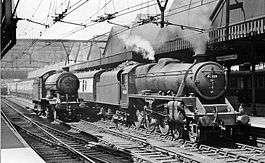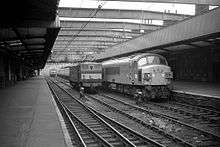Sheffield Victoria railway station
Sheffield Victoria was the main railway station in Sheffield, Yorkshire, England, on the Great Central Railway, between Chesterfield and Penistone.
| Sheffield Victoria | |
|---|---|
 Sheffield Victoria, as seen in 1957 | |
| Location | |
| Place | Wicker, Sheffield |
| Area | City of Sheffield |
| Coordinates | 53.387470°N 1.458760°W |
| Grid reference | SK362880 |
| Operations | |
| Pre-grouping | Manchester, Sheffield and Lincolnshire Railway Great Central Railway |
| Post-grouping | London and North Eastern Railway London Midland Region of British Railways |
| Platforms | 5 |
| History | |
| 15 September 1851 | Opened |
| 5 January 1970 | Closed |
| Disused railway stations in the United Kingdom | |
| Closed railway stations in Britain A B C D–F G H–J K–L M–O P–R S T–V W–Z | |
History
Early history
Engineered by Joseph Locke, the Sheffield, Ashton-under-Lyne and Manchester Railway linking Manchester and Sheffield opened in 1845. Originally, this line terminated at the Bridgehouses station about 0.7 miles (1 km) to the west of the future Victoria station. In 1847, the Sheffield, Ashton-under-Lyne and Manchester Railway merged with two other railway companies to form the Manchester, Sheffield and Lincolnshire Railway. The station at Bridgehouses had been outgrown and an extension and new station were planned. John Fowler, who later gained fame for co-designing the Forth Railway Bridge in Scotland, was employed to engineer the extension and station. Fowler's design included a viaduct over the Wicker that was 40 feet (12 m) high, 750 yards (690 m) long and two island platforms 1,000 ft (300 m) long. The extension was completed in 1847–1848 and the new Victoria station opened on 15 September 1851. The station gained a 400 ft (120 m)-long ridge furrow patterned glass roof likened at the time to The Crystal Palace (in London) which spanned the main line platforms in 1867 and was further enlarged in 1874, the well-known railway contractors Logan and Hemingway being awarded the contract.
With the opening of the London Extension in 1899, Sheffield gained a new direct service to London. To attract the lucrative trade between the cities, the Great Central Railway launched Sheffield Without A Stop on 1 July 1903[1] and became something of a trademark for the company, with 163.75 miles (263.53 km) being run in exactly 3 hours, an average of nearly 55 miles per hour (89 km/h).[2] Slip coaches were provided for passengers for Leicester and Nottingham.[1]
The station received a new frontage in 1908 and was further improved between 1939 and 1940.[3] The station took on great importance when the line through the Pennines—known as the Woodhead Route after the long Woodhead Tunnel on it which was electrified for freight purposes after World War II.
Electrification

The 1950s saw the station at its zenith: Regular Manchester London Road – Sheffield Victoria – London Marylebone express services traversed the Great Central line, other expresses ran to London King's Cross over the East Coast Main Line and the named expresses the Master Cutler, the Sheffield Pullman and the South Yorkshireman served the station. There were also many semi-fast trains running trans-Pennine from Manchester to destinations on the East Coast, and local trains to Chesterfield, Barnsley, Nottingham, Doncaster, Retford, Penistone and Lincoln.
The electrification of the line reached Sheffield Victoria by 1954, reducing the journey time to Manchester to 56 minutes. This was the only main line electrified at 1500 V d.c. From this point onwards, all passenger trains heading to Manchester required a change of locomotive at Victoria to a British Rail Class 76 or express passenger British Rail Class 77.
Closure

Although the 1950s saw services at the station reach their peak, this period also marked the beginning of its decline. In 1953 Barnsley was an early casualty as the line ran almost parallel to the former Midland Railway's Sheffield Midland – Barnsley line, serving mostly the same communities. By the end of the decade, the expresses to Marylebone were either cut or re-routed to King's Cross (in the case of the Master Cutler). In the mid-1960s there was a concerted effort to concentrate Victoria's remaining local and express train services at Sheffield (Midland) station. From 4 October 1965 most services were diverted to Sheffield Midland, adding 2 to 4 minutes to their schedules. The only trains remaining were Manchester via Woodhead, the Harwich boat train and trains to Bournemouth, York and Swindon.[4] After September 1966, Victoria was left with just an hourly Manchester service and the daily Liverpool-Harwich "Continental" Boat train service.
In 1965 the second Beeching Report recommended that the Sheffield to Manchester service be consolidated; after much local wrangling British Railways favoured the Hope Valley Line which was slower and not electrified but served more local communities. In 1967, plans were announced to withdraw passenger services along the Woodhead route. Following public outcry, an inquiry was launched that took two years to be completed. Eventually the inquiry backed British Rail's plans and passenger services were withdrawn from the line on 5 January 1970. The last train to Victoria station, an enthusiasts' special, arrived at 00:44 on 5 January and from that point the station was closed.
The station re-opened very briefly in 1972 for diverted trains while Sheffield (Midland) station was closed for re-signalling.
The Manchester-Sheffield-Wath electric railway was entirely closed east of Hadfield in July 1981; and the tracks through the Woodhead Tunnel were lifted in 1986. Passenger trains to and from Huddersfield via Penistone continued to pass through the station without stopping until May 1983, when they were diverted via Barnsley (the Penistone via Wadsley Bridge section then being closed to passenger traffic). Except for the now single track goods avoiding line, which still exists to serve the steelworks at Stocksbridge, all the track through the station was lifted by 1985[5] and the station buildings were demolished in 1989 to make way for an extension to the adjacent Victoria Hotel complex. The slope that once led up to Platform 1 survives as part of a pedestrian path to the car park.
Preservation
Outlines of the platforms still remain, and the trackbed has been protected for a possible future extension of the Sheffield Supertram,[6] and may also be used for the proposed Don Valley Railway, which will terminate at Nunnery, linking into the Supertram approximately 1,300 yards (1,200 m) to the east where the proposed DVR will also interchange with train services on the Sheffield to Lincoln Line.
| Preceding station | Disused railways | Following station | ||
|---|---|---|---|---|
| Bridgehouses | British Railways Great Central Main Line |
Darnall | ||
| Bridgehouses | LNER Great Central Railway Manchester, Sheffield Victoria-Doncaster Line |
Attercliffe |
Future and potential reopening
It was suggested by Sheffield City Council that the site could be used for Sheffield's HS2 station, instead of the then planned station at Meadowhall, although an alternative route announced in 2016 would see HS2 using the existing Sheffield station, formerly known as Sheffield Midland station.[7][8]
In May 2020 as part of the Restoring Your Railway fund by the Department for Transport, it was announced that the Barrow Hill Line had been awarded funding for a feasibility study. If proven feasible, the line would initially run to Sheffield Midland but later phases could see services diverted to a reopened Sheffield Victoria with services running to Chesterfield (via the Barrow Hill Line) and services to Huddersfield (via a reopened Don Valley Line between Penistone and Sheffield) which would help free up capacity at Sheffield Midland for the additional services planned under HS2 and Northern Powerhouse Rail. [9][10][11][12] Later pathing extensions could see a restored Sheffield Victoria see services running to Lincoln (via Retford), Nottingham (via Chesterfield) and Huddersfield (via Penistone).[10]
Station Masters
- William Taylor ca. 1852
- Mr. Ward ca. 1857
- Mr. Brown
- J.A. Hodkinson ca. 1885 – 1895?
- William Morley 1895? – 1903[13]
- T.A. Moorhouse 1903 – 1924[14]
- R.F. Ogden 1924 – 1935[15]
- Robert Bruntlett 1935 – 1939[16]
- E.O. Wright 1940 – 1941[17]
- W.W. Capon 1941 – 1944[18]
- W.H. Burton ???? – 1949 (afterwards stationmaster at York)
- Mr. Williamson ca. 1962
In popular culture
- Sheffield-based industrial music pioneers Cabaret Voltaire filmed the video to their track "Yashar" in the remains of the station in the early-1980s; at one point a Class 20 hauled freight train is seen passing through. The band was noted for the use of decaying urban scenery in its videos.
See also
- Sheffield railway station (formerly Midland Station)
- Sheffield Wicker railway station
References
Notes
- "Great Central Railway Summer Express Train Service. Vestibuled Breakfast Car Train Sheffield to London Without A Stop. Commencing 1 July 1903". Sheffield Daily Telegraph. British Newspaper Archive. 25 June 1903. Retrieved 23 July 2016 – via British Newspaper Archive.
- "Railway Enterprise. Important move by the Great Central Railway". Folkestone, Hythe, Sandgate & Cheriton Herald. British Newspaper Archive. 7 November 1903. Retrieved 23 July 2016 – via British Newspaper Archive.
- Anderson 2002, p. 246.
- Modern Railways October 1965 p. 583
- Victoria Station, SheffieldSignalboxes.com; Retrieved 10 June 2016
- Sheffield Victoria at Subterranea Britannica
- "Report suggests HS2 station in central Sheffield". Railnews. Retrieved 12 March 2014.
- "City claims victory on HS2 station move". BBC News. 28 June 2016. Retrieved 1 December 2017.
- "Restoring Your Railway Fund". GOV.UK. Department for Transport. 23 May 2020. Retrieved 23 May 2020.
- Plans submitted which could lead to former rail stations re-opening in North Derbyshire towns peakfm 25 June 2020. Retrieved 13 July 2020
- Passengers to return to Sheffield Victoria TransportXtra 13 July 2020. Retrieved 13 July 2020
- Fresh talks planned over campaign to reopen Sheffield railway line The Star. 28 May 2020. Retrieved 13 July 2020
- "Promotion for a Sheffield Stationmaster". Sheffield Daily Telegraph. England. 2 February 1903. Retrieved 2 September 2017 – via British Newspaper Archive.
- "Great Central Stationmaster Retires". Sheffield Daily Telegraph. England. 26 February 1924. Retrieved 2 September 2017 – via British Newspaper Archive.
- "Station Chief's Lively Memories". Sheffield Independent. England. 8 December 1934. Retrieved 2 September 2017 – via British Newspaper Archive.
- "Tribute to Retired Stationmaster". Sheffield Daily Telegraph. England. 23 November 1939. Retrieved 2 September 2017 – via British Newspaper Archive.
- "Former Driffield Station Master Retiring". Driffield Times. England. 13 April 1946. Retrieved 2 September 2017 – via British Newspaper Archive.
- "New Stationmaster". Hull Daily Mail. England. 18 March 1944. Retrieved 2 September 2017 – via British Newspaper Archive.
Sources
- Anderson, Paul (March 2002). Hawkins, Chris (ed.). "Sheffield Victoria". British Railways Illustrated. Berkhamstead, Herts: Irwell Press Ltd. 11 (6).CS1 maint: ref=harv (link)
External links
| Wikimedia Commons has media related to Sheffield Victoria railway station. |